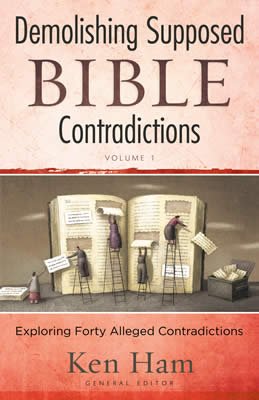Demolishing Supposed Bible Contradictions: Volume 1

Do you have concerns about Bible passages that have bothered you for years? This book is based on many of the most-asked questions about supposed Bible contradictions and errors.
Only select chapters are available in the online version of this book.
Contents
Acknowledgments, Special Thanks, and Copyright Information
The book Demolishing Supposed Bible Contradictions Volume 1 has been graciously provided at no charge to Answers in Genesis by Master Books, a division of New Leaf Press (Green Forest, Arkansas).
We would like to say thanks to all the reviewers of the various chapters in this book. They are: Steve Fazekas, Dr. Terry Mortenson, Frost Smith, Peter Galling, Roger Patterson, Paul F. Taylor, Stacia McKeever, Gary Vaterlaus, Dr. Jason Lisle, Dr. Georgia Purdom, John UpChurch, Ken Ham, and Dr. Tommy Mitchell.
By downloading this material, you agree to the following terms with respect to the use of the requested material: Answers in Genesis grants you a non-exclusive, non-transferable license to print or download one (1) copy of the copyrighted work. The copyrighted work will be used for non-commercial, personal purposes only. You may not prepare, manufacture, copy, use, promote, distribute, or sell a derivative work of the copyrighted work without the express approval of Answers in Genesis. Approval must be expressed and in writing, and failure to respond shall not be deemed approval. All rights in the copyrighted work not specifically granted to you are reserved by Answers in Genesis. All such reserved rights may be exercised by Answers in Genesis. This Agreement, and all interpretations thereof, shall be deemed to be in accordance with Kentucky law. Any dispute arising out of this Agreement shall be resolved in accordance with Kentucky law in the Circuit Court of Boone County, Kentucky, which court shall be deemed to be the court of proper jurisdiction and venue.
Portions of this book are reprinted with permission, courtesy of Master Books.

Answers in Genesis is an apologetics ministry, dedicated to helping Christians defend their faith and proclaim the good news of Jesus Christ.
- Customer Service 800.778.3390
- Available Monday–Friday | 9 AM–5 PM ET
- © 2026 Answers in Genesis
